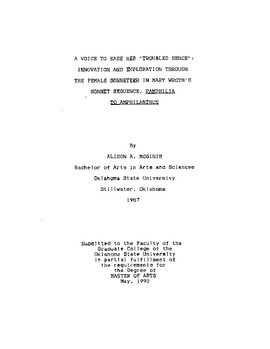| dc.contributor.author | McGinis, Alison A. | |
| dc.date.accessioned | 2014-12-17T20:26:21Z | |
| dc.date.available | 2014-12-17T20:26:21Z | |
| dc.date.issued | 1990-05-01 | |
| dc.identifier.uri | https://hdl.handle.net/11244/13966 | |
| dc.description.abstract | The depth and range of emotions in Lady Mary Wroth's sonnet sequence, Pamphllla to Amphllanthus, intrigued me from the first moment I encountered her poetry in a graduate seminar at Oklahoma State University. As I began to consider her work as part of the poetic tradition of Renaissance sonnet sequences, such as her uncle Philip Sidney's Astrophil and Stella, I was disheartened to reallze that many critics have focused on Wroth's poetry merely to search for interesting autobiographical details. Other critics have become enthralled with the seventeenth-century scandal which surrounded the publication of her work, diverting attention away from the capabilities of a female poet attempting to respond creatively and critically under unquestionable societal constraints. Understanding that Wroth wrote in a social and literary climate that insisted upon silence, obedience, and chastity as the definitive qualities of a virtuous woman, I began to question what difference the female voice of Pamphilla makes to Pamphilla to Amphllanthus--a sequence which is part of a male-dominated tradition. Reading the poems as the self-exploration of the sonnet speaker, I encountered ambivalence in the voice due to the conflict between the powerful role of the sonneteer and the limitations of a seventeenth-century woman. This study does not try to prove that Lady Mary Wroth wrote very early feminist poetry; it does, however, aim to present Wroth's innovations through a discussion of Pamphilla' s various responses to her role as female sonneteer. | |
| dc.format | application/pdf | |
| dc.language | en_US | |
| dc.publisher | Oklahoma State University | |
| dc.rights | Copyright is held by the author who has granted the Oklahoma State University Library the non-exclusive right to share this material in its institutional repository. Contact Digital Library Services at lib-dls@okstate.edu or 405-744-9161 for the permission policy on the use, reproduction or distribution of this material. | |
| dc.title | Voice to Ease Her "troubled Sense" : Innovation and Exploration Through the Female Sonneteer in Mary Wroth's Sonnet Sequence, Pamphilia to Amphilanthu | |
| dc.type | text | |
| osu.filename | Thesis-1990-M145v.pdf | |
| osu.accesstype | Open Access | |
| dc.description.department | English | |
| dc.type.genre | Thesis | |
